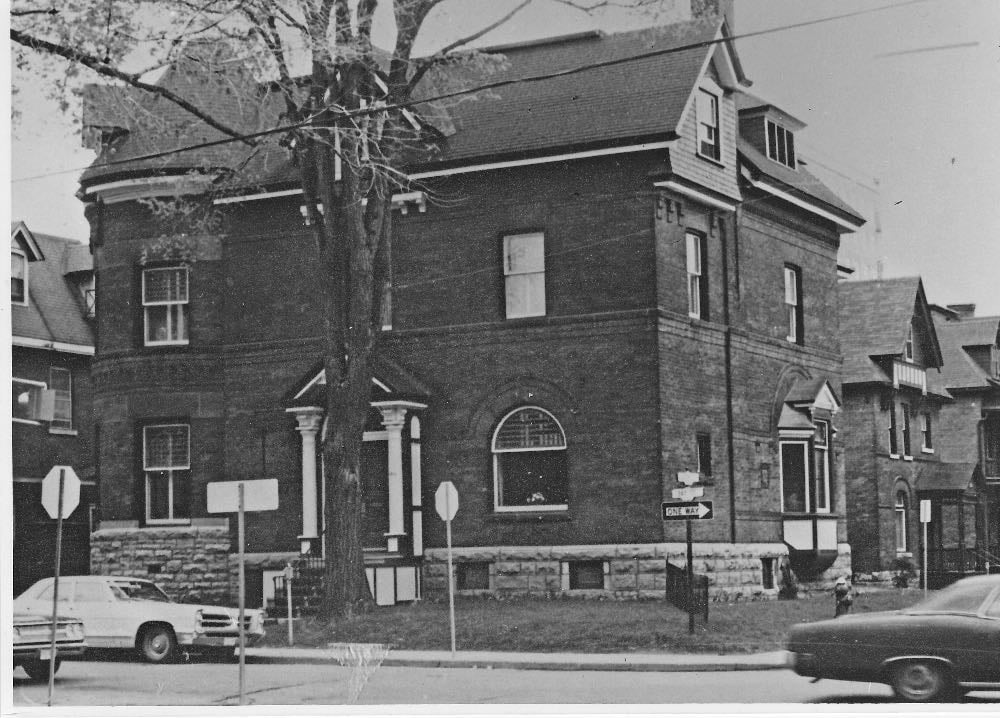Complexity is written all over the Queen Anne Revival building we see here. And for good reason. It reminds us that a diocese is a very challenging entity to create and keep going. The Diocese of Ottawa is a case in point.
For a quarter of a century, between 1871 and 1895, Bishop John Travers Lewis had labored mightily to carve a new diocese—Ottawa—out of the northern and eastern sections of the Diocese of Ontario. As difficult as that had proven, the agonies of the new creation had been eased with the election of Charles Hamilton, Bishop of Niagara, to become the first Bishop of Ottawa in 1896. To put it baldly, Hamilton had inherited wealth from the family sawmills at Hawkesbury, and as a result, the Diocese was spared the expense of building a residence (grandly termed a bishop’s palace) for the first bishop who soon came to be known as Archbishop Hamilton. In a diocese with an ongoing clergy shortage, yet building new churches all the while, it was a boon for diocesan finances not to have to worry about where the bishop and his family would lay their heads at night.
That all changed 20 years on, when Hamilton retired. His successor, John Charles Roper, Bishop of British Columbia, was elected in 1915. The new Bishop of Ottawa was a formidable theologian, having taught at General Theological Seminary in New York. Although his grandfather in Frant, England was executor of Colonel John By’s will (builder of the Rideau Canal), Bishop Roper, although rich in theology, was somewhat thin of purse. The diocese needed to provide him with a home. They did so handsomely, coming up with this imposing residence on the southwest corner of Bay and Queen Streets in uptown Ottawa.
We may wonder if some of the details were added by the bishop’s son, architect John Bethune Roper. This address quickly came to be known as Bishopscourt. It was down the block from the cathedral and Lauder Hall where the annual synod was held. In a word, it was handy. Its purchase may even have been responsible for the rise of the term, “the Ecclesiastical Block” long before most property in the vicinity of the cathedral was acquired by the Diocese.
Alas, this is the only known photograph of Bishopscourt to exist. It was taken in the 1970s, before disease decimated the ranks of the stately elm trees lining the streets of downtown Ottawa. One of those elms blocks our view of the front entrance of Bishopscourt here, but that is no matter. We can comprehend a timorous clergyman waiting on the front step for his interview with the Bishop, looking up at the arch of the stained glass transom framed by the Corinthian columns of the portico, and knowing he was at a good address.
If Bishop Roper had his challenges, he was more than equal to them. When his wife became an invalid her room was on the ground floor in the turret beside the front door. Roper had no secretary. He ran the diocese from the room with the oriel window fronting on Queen Street (far right). He created the first clergy register and wrote all correspondence. His home here was the first archives thirty years before one was formally established; overflow files were stored in his basement. His office overlooked the cathedral where he insisted that the chancel be enlarged to a size able to accommodate a men and boys choir in 1932.
Some time after it ceased to be Bishopscourt, the ‘bishop’s palace’ burned down in February 1977.
At that time Dorothy Cowan, daughter of Bishop Robert Jefferson, remembered the house as an airy, light-filled castle. “Gracious is the best word for it,” she said. “Everything about the house was big and beautiful.”
Mrs. Cowan said the interior was covered in intricately-carved oak and mahogany panelling. “The first thing that hit you when you walked in the door was the staircase,” she recalled. “It didn’t exactly spiral, it was more like a curve, a gentle curve. And the whole thing was solid wood, ornately crafted. Then you realized the size of the entrance you were standing in. It was huge.”
The provision for servants also impressed Mrs. Cowan. “It made you feel like you were in some sort of mansion,” she said. “There was a system of bell cords in each room to call the maids from the quarters for them in the rear of the house.”
From outside, the house’s most noticeable feature was its supply of windows. From the corner of Bay and Queen, passersby would count at least eight. “I can still remember how huge the bay windows in the living room and bedrooms were,” said Mrs. Cowan. “They just added to the grandness of the place.”
The last occupant of Bishopscourt was Bishop Ernest S. Reed. His widow recounted in 1977 that the one thing that stuck in her mind about the house was the amount of decorative glass. “Many of the doors in the house had lovely beveled glass over them,” she said. “I especially remember one of the bigger stained glass windows near the entrance. It had a Latin inscription that read Dum Spiro, Spero or ‘while there is life, there is hope’. I thought that was particularly appropriate. The house was a grand place to entertain,” she said. “I never had any trouble packing in 300 people at a time. And fireplaces! You never saw so many in one house. I think, all told, there were four of them.”
The third floor of the building, said Mrs Reed, was perfect for children. “When we moved in, we found this huge recreation room with a big old billiard table in it,” she said. “We had to get rid of the table because it was warped, but the third floor was always ideal for a rainy day.
After Bishop Reed died in 1973, the old residence was sold and turned into a restaurant. Mrs. Reed returned for a meal. “It made a lovely restaurant,” she said. “I’m only sorry they had to remove a lot of the glasswork.”
As testimony to the size of the house, Mrs. Cowan’s oldest son told of his impressions years later when he returned for a luncheon date to the building that he visited so many times as a child. “Usually, the things you remember as really big when you were a kid seem to shrink as you grow older,” he said. “But when I got inside, I found my memory served me correctly. It was just as big as it ever was.”
The Diocesan Archives collects parish registers, vestry reports, service registers, minutes of groups and committees, financial documents, property records (including cemeteries and architectural plans), insurance policies, letters, pew bulletins, photographs and paintings, scrapbooks, parish newsletters, and unusual documents.G


Listening for God’s voice in a time of change